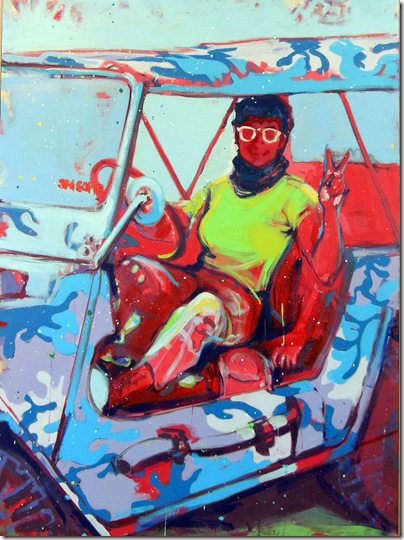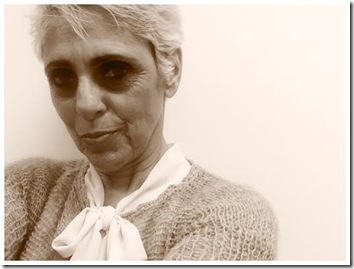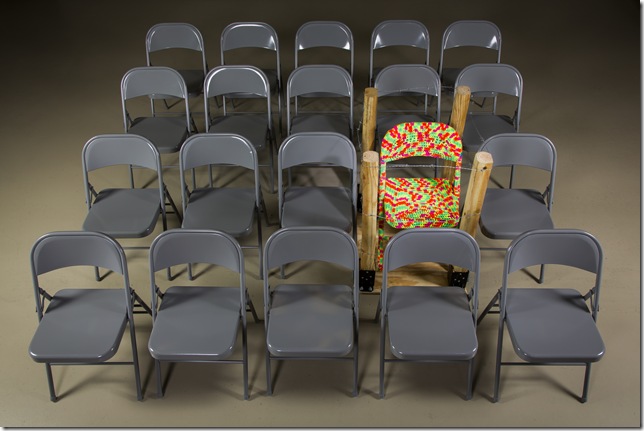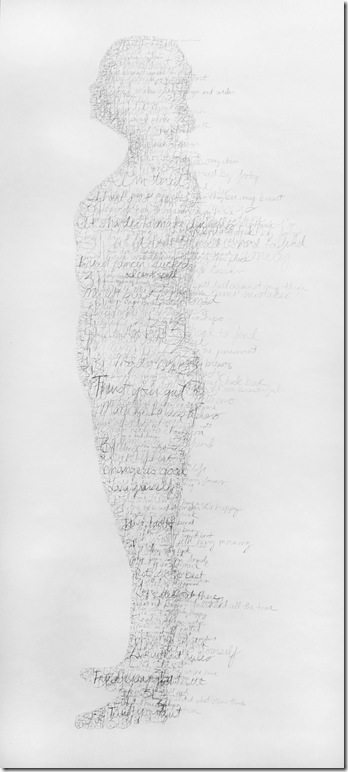By Colleen Dougher
A Plexiglas house designed to hold secrets, a self-portrait based on a 30-year-old photograph, a powerful 20-chair installation, big drawings comprised of handwritten fears, insecurities and affirmations and a found mannequin with a hidden but beautiful world inside.
These are among the treasures that can be found when Which Way Out: Personal Thoughts Made Public opens Friday night at Studio 18 in Pembroke Pines.
Jill Slaughter, special projects curator at the city-run artist colony, asked seven South Florida artists to interpret the struggle over deciding what information to reveal to others and what to keep a secret.
As with each show Slaughter curates, the exhibition will include a “civic engagement component,” and this time around she’s focused her energy on lesbian, gay, bisexual and transgender youths, some of whom may have their own struggles over what to share.
“I have been reading about LGBT youth and [how] their statistics of drug addiction, hurting themselves, cutting themselves, suicide attempts and actual suicide … are significantly higher than the population of kids that same age who are not LGBT,” Slaughter says. “So I wanted to be able to do something to have a platform for that somehow.”
As such, a portion of Studio 18 will be designated for visual and literary works by the Pembroke Pines Charter High School’s Gay-Straight Alliance (GSA), and Friday’s opening reception will feature performances by GSA members and The Original Fort Lauderdale Gay Men’s Chorus.
While a few of the artists in Which Way Out explore themes of “coming out,” and all that accompanies that, Slaughter stresses that her mission was simply to scope out artists who address the general themes of privacy and secrets through their work. No one, after all, is immune to the risks — or rewards — of sharing personal information.
“I had been following Lori Nozick’s career for quite awhile and knew that I wanted to work with her but wasn’t really sure how we would work together,” Slaughter explains. “She said she had been thinking for awhile about doing this project called ‘The Secret House’ and we started talking about that and how that could really be a platform for anybody. Everybody is carrying some kind of secret.”
Secrets, as Nozick points out, are human nature, and the reason some people keep personal diaries. “I believe that we look at other people’s lives and we see them as looking a certain way, but we don’t really know what’s going on in the interior,” the Miami artist says.
Nozick explores that interior-versus-exterior theme through The Secret House, a project in which visitors are invited to write their secrets on pieces of paper, which they can fold or crumple before tossing into the slot of her 4-and-a-half-foot high Plexiglas structure.
The public may not be able to read their secrets or know who wrote them, but because the walls are transparent, the crumpled and folded papers can still be seen, and the house, in a sense, “keeps” the secrets, just as one might expect a friend to do. As the artist, Nozick also “keeps” those secrets.
Coral Gables painter Jacqueline Gopie is intimately familiar with secrets. As a lesbian, she was admittedly very closeted during her 22 years in the military.
“I lived a dual life for all those years, seldom letting my fellow soldiers into my private world,” she explains. “Looking back it was such a stressful existence, always living with the fear of getting tossed out any minute for being a dyke.”
After retiring from the military 12 years ago, Gopie earned her MFA in painting from the University of Miami and has since participated in many exhibitions, but the artist says her most recent work is the first in which she addresses her sexuality.
The painting, titled Big Island, 1983, is a large self-portrait inspired by a photo taken of Gopie when she was 23 and sitting in a Jeep in Hawaii, where she was stationed at the time. Last year, Gopie returned to Hawaii and while waiting on a rental car at the airport, encountered a young woman in the military who was wearing a shirt that read “I’m not a lesbian but my girlfriend is.”
Gopie was happy to see someone in the military being so forthright about their sexual orientation, and says: “I was struck by the thought that 30 years ago, I would not have even dreamt of saying the word ‘lesbian’ out loud in public, much less wear a T-shirt that implied I was one.”
More recently, Gopie visited her mother, who handed her the 1983 photograph that became the impetus for the self-portrait she’ll exhibit at Studio 18. As Gopie notes in an a statement that will accompany the work, “This portrait of me as a young soldier relaxing in her Jeep is my coming out — 30 years later.”
Revealing a long-held secret of any kind may be freeing, but can also also result in the sort of alienation represented in two works by Miami artist Randy Burman.
Discrimination Seating features 20 chairs lined up in four rows. All are standard gray metal folding chairs with the exception of one, which has been colorfully yarn-bombed and confined inside wooden posts connected by thorny barbed wire.
Similarly, Burman’s other installation — Family Portraits — is a group of 15 framed photographs of families in which at least one person’s face is obscured. Instead of eyes, nose and a mouth, we just see a round blank white space. It’s as if they no longer exist or are not part of the family anymore.
Burman says his depiction is meant to reflect the isolation and ostracization people must feel when their families reject, threaten or abuse them because of their sexual orientation.
But the term “sexual orientation” could easily be replaced with “religious beliefs,” “political beliefs” or even “differing opinion.” There are many things people hesitate to reveal, often to avoid being judged, ridiculed or attacked, yet the things that people keep secret are often things that could unite us.
Peer inside Fort Lauderdale artist Donna Haynes’s sculpture titled 13 looking at 31 looking at 13 and you’ll find a hidden world with books, flowers, birds and female forms. Woven throughout are strips of text that spell out fears, insecurities and affirmations. The sculpture will be accompanied by large-scale photos of the sculpture’s interior and a pair of 7-foot-high drawings titled Things Change and Still the Same 13, and Things Change and Still the Same 31.
One graphite-on-paper drawing depicts the form of a teenager, and the other a 31-year-old woman. Both are formed from layers of handwritten tidbits. They’re the sort of things we may hear from others or tell ourselves — things like “Bring a guy when you buy a car,” “I drink too much,” “Love yourself,” and “Trust your gut.”
“Each of these pieces deal with reflection,” Haynes notes in a statement about her work. “My intention was to reflect on [my] and others’ many fears and insecurities at the age of 13 and then later at the age of 31. … My hope is that my audience will reflect and share stories of their own lives to others as I feel that is the point of our existence: to share, meet others, hear their stories, form relationships, interact, make friends, love, and record a lineage.”
Which Way Out: Personal Thoughts Made Public, which also includes work by Nestor Arenas, Philip Ross Munro and Sara Stites, will open 7-10 p.m. Friday and run through April 3 at Studio 18 in the Pines, 1101 Poinciana Drive, Pembroke Pines. For more info, contact Jill Slaughter, 954-450-6947 or Jslaughter@ppines.com.



